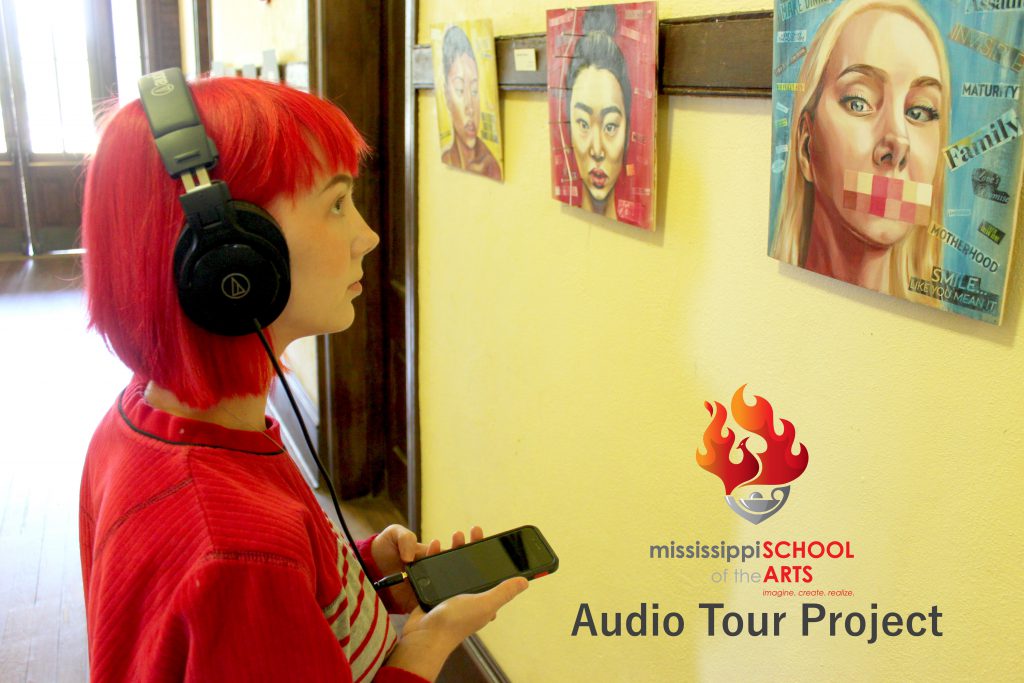 Photo // Lucie Cooper, a senior visual student from Jackson, MS, demonstrates an audio tour of art by senior Elizabeth Wynne, a visual student from Pickens, on display at Mississippi School of the Arts. Audio tours are most known in art galleries and museums around the world, but MSA students will get the opportunity to experience the same concept here in high school.
Photo // Lucie Cooper, a senior visual student from Jackson, MS, demonstrates an audio tour of art by senior Elizabeth Wynne, a visual student from Pickens, on display at Mississippi School of the Arts. Audio tours are most known in art galleries and museums around the world, but MSA students will get the opportunity to experience the same concept here in high school.
When registering for a self-guided tour at major art and historical museums, another option is usually offered. Audio tours, the use of an audio player device for interaction, have been incorporated as curator guides for years, but rarely seen outside of major cities.
Mississippi School of the Arts (MSA) will test this tour option at an upcoming showcase to begin November 1st at the Lincoln-Lawrence-Franklin Regional Public Library in Brookhaven, MS. In a direct collaboration with the MSA Technology Department, a mobile-sized web site was created for audio tracks to be housed and showcased.
“This is unique and will be offered for the first time. I want to give junior and senior students some technological experience and knowledge of audio tours and let them see how audio tours work. Then, maybe, they can apply the knowledge to their future projects either here at MSA, at the college level or in their workplace,” said Patrick Brown, MSA’s technology coordinator.
According to Brown, the recording sessions have been enriching. “We are looking forward to a great learning experience and a positive outcome by the community. I’ve enjoyed recording the students and hearing their stories,” he said.
When visitors arrive to the public library in Brookhaven, they’ll enter the Vernon Room and scan a posted Quick Response (QR) code using their smartphone or tablet computer with internet access. A QR code is similar to a barcode of sorts, storing URLs and other information of interest. QR codes are growing in popularity at conference events, magazines, billboards, web pages, and even embroidered items. The exhibition’s QR code will launch a special web site containing the audio library of the exhibit. From there, visitors can walk up to each exhibit and listen to the tour with personal headphones.
The exhibition, “A Self-Portrait,” gives visitors a facial look from the artist’s perspective. The idea is to record each student in their own voice while guests look at their portrait artwork. The perception draws a closer connection between the artist and the guest, especially when you hear the actual voice of the artist.
“The audio tours will help our students by allowing their voice to be heard. It will put a name with their art and it will give them more exposure with the public. I have never experienced any audio tours at any college or any showcase that I have ever attended, and the only museums that I have ever witnessed any audio tours were at history museums,” said Maurice Calvert, an instructor in MSA’s visual arts department.
Audio tours don’t have to be connected only with museums and galleries. Cities and tourism development agencies have created tours to showcase downtown attractions and even national parks. Audio tours can draw revenue, too. Although our tours will be free, most art galleries and museums start at $5.00 for rental of audio devices and headphones, but revenue generating extends outside of museums. This site, for instance, allows you to create and sell audio tours for basically any location in the world. Essentially, it’s an online platform for digital audio storytellers (https://www.voicemap.me).
“The concept of the audio tours has changed over the years. When I was a young child, I remember wearing headphones and listening to a cassette tape tour that guided me through the galleries. Some museums were fortunate to have a choice of adult tours and tours for children. Now, technology has changed to the point that museums can be completely interactive and immersive. Museums strive to engage viewers in an experience that allows each person to individually participate in the artwork. With our students at MSA, we have created a showcase of self-portraits that not only visually tell stories about each student, but also allow the viewer to hear the stories of each student in their own voice,” said Kelly Varner, an instructor in MSA’s visual arts department.
“My goal as an educator is to introduce the students to this technology and to see what they will design in the future. Each of our students will design a showcase while they are here, and many will utilize technology like this to further tell their stories,” she said.
Visitors to the gallery should be prepared to bring a smartphone or tablet with internet access and personal headphones. We ask that headphones be worn during the tour so other visitors and public library patrons will not be distracted.
The exhibit and audio tour will begin November 1st and end November 29th, 2018.
